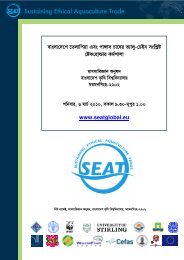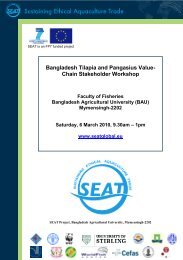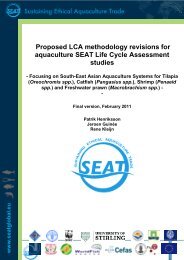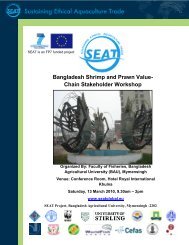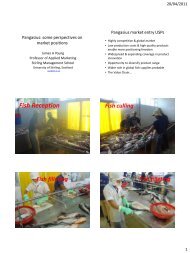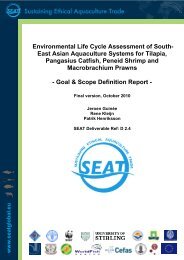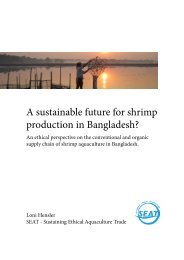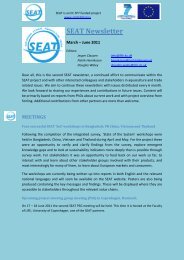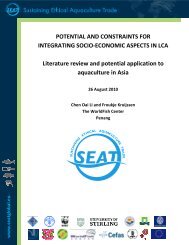D4.1 Review of Environmental Models - SEAT Global
D4.1 Review of Environmental Models - SEAT Global
D4.1 Review of Environmental Models - SEAT Global
Create successful ePaper yourself
Turn your PDF publications into a flip-book with our unique Google optimized e-Paper software.
now follows the material flows through a system. It is now a stock and flow model as it is<br />
built in STELLA and can provide a visual aid for pollution flows (Schaffner et al, 2009).<br />
The MMFA has been used in conjunction with WASP in Thailand on a catchment known as<br />
the Thachin River Basin (Schaffner et al., 2007), which is perceived as the most polluted river<br />
in Thailand (Simachaya, 2003). The MMFA was used to quantify the nutrient loading and<br />
consequent carrying capacity <strong>of</strong> the river, by taking into account both agriculture and<br />
aquaculture activities simulating the loading from each to determine the largest polluter in<br />
terms <strong>of</strong> nitrogen and phosphorus (Schaffner et al., 2009). The model confirmed that<br />
aquaculture was the most significant nutrient polluter in the Thachin River (Schaffner et al,<br />
2009). The benefit <strong>of</strong> this mode was simulations could be carried out using whatever data<br />
was available (Schaffner et al., 2007). This is a clear advantage as there is <strong>of</strong>ten a paucity <strong>of</strong><br />
data in such systems. It is also advantageous as the model can be easily adapted for use in<br />
other similar aquatic systems and where data is limited.<br />
It is unadvisable to use the MMFA model on its own for any decision on catchment<br />
management. It is desirable to use it in combination or to complement a system dynamics<br />
model to provide a wider understanding <strong>of</strong> the workings and carrying capacity for any<br />
aquatic system (Schaffner et al., 2007).<br />
1.3.7 SWAT (Soil and Water Assessment Tool)<br />
SWAT is a long-term assessment tool for simulations <strong>of</strong> watershed dynamics (Ullrich & Volk,<br />
2009). The basic design <strong>of</strong> SWAT is in three layers: the sub-basin, reservoir routing and<br />
channel routing (Spruill et al., 2000). SWAT was originally developed for use with nutrient<br />
loading <strong>of</strong> water sources from land based activities (Huang et al, 2009), and has been used<br />
for estimating nutrient loads to local watersheds in relation to salmon farming.<br />
SWAT2000 was used in the Cannonsville reservoir in New York to simulate nutrient loading<br />
<strong>of</strong> agricultural practices on the surrounding land, taking into consideration sediment flows<br />
(Tolson & Shoemaker, 2004). Although the model was effective in showing some useful<br />
findings, it was not effective in showing phosphorus loading as a validation method. There<br />
were significant errors between empirical data and simulations (Tolson and Shoemaker,<br />
2004). However, the model demonstrated that agricultural land used for corn was the main<br />
contributor to phosphorus loading to the reservoir, even though the land used for this<br />
purpose only took up approximately 1.2% <strong>of</strong> the survey area (Tolson & Shoemaker, 2004).<br />
SWAT is a popular model as it has been used in a number <strong>of</strong> further studies:<br />
In Kentucky to determine monthly run<strong>of</strong>f in karst areas and was found to have<br />
effective analysis and simulation results for the system in this respect (Spruill et al.,<br />
2000)<br />
In the Vantaanjoki basin in Finland (Barlund & Kirkkala, 2008) to determine<br />
management efficiency in simulating the nitrogen and phosphorus flow in<br />
catchment and water bodies under the Water Framework Directive (WFD) (Barlund<br />
& Kirkkala, 2008). In this case the model did not allow for nitrogen input from<br />
forestry, which is significant and thus limited the model’s use for the present.<br />
However, this can be adapted and used more effectively for management under the<br />
WFD in future (Barlund et al, 2007).<br />
Page 17



